
Ficus microcarpa, also known as Chinese banyan, Malayan banyan, Indian laurel, curtain fig, or gajumaru (ガジュマル), is a tree in the fig family Moraceae. It is native in a range from China through tropical Asia and the Caroline Islands to Australia. It is widely planted as a shade tree and frequently misidentified as F. retusa or as F. nitida.

Terminalia is a genus of large trees of the flowering plant family Combretaceae, comprising nearly 300 species distributed in tropical regions of the world. The genus name derives from the Latin word terminus, referring to the fact that the leaves appear at the very tips of the shoots.

Syzygium cumini, commonly known as Malabar plum, Java plum, black plum, jamun, jaman, jambul, or jambolan, is an evergreen tropical tree in the flowering plant family Myrtaceae, and favored for its fruit, timber, and ornamental value. It is native to the Indian subcontinent and Southeast Asia, including Myanmar, Sri Lanka, Bangladesh and the Andaman Islands. It can reach heights of up to 30 metres (98 ft) and can live more than 100 years. A rapidly growing plant, it is considered an invasive species in many world regions.
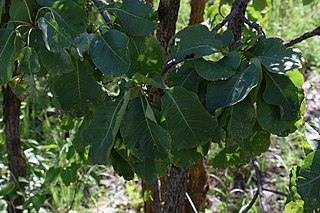
Terminalia ferdinandiana, most commonly known as the Kakadu plum and also called the gubinge, billygoat plum, green plum, salty plum, murunga, mador and other names, is a flowering plant in the family Combretaceae, native to Australia, widespread throughout the tropical woodlands from north-western Australia to eastern Arnhem Land. Used as a traditional bush food and bush medicine for centuries, the fruit has especially high levels of vitamin C.

Pleiogynium timoriense, commonly known as the Burdekin plum, sweet plum, tulip plum, or in the Djabugay language guybalum, is a medium-sized fruit-bearing tree in the cashew and mango family Anacardiaceae native to Malesia, Australia and the Pacific Islands.
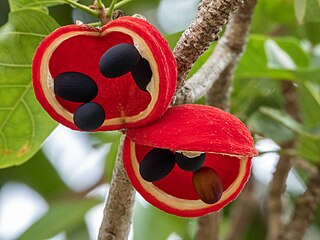
Sterculia quadrifida, also known as the peanut tree, monkey nut or red-fruited kurrajong is a small tree that grows in the rainforests, vine thickets, and gallery forests of New Guinea and northern Australia.

Elattostachys is a genus of about 21 species of trees known to science, constituting part of the plant family Sapindaceae.

Grevillea agrifolia, the blue grevillea, is a species of flowering plant in the family Proteaceae and is native to the north of Western Australia and parts of the Northern Territory. It is a shrub or tree with narrowly oblong leaves with the narrower end towards the base, and creamy-yellow flowers.

Xylocarpus granatum, commonly known as the cannonball mangrove, cedar mangrove, or puzzlenut tree, is a species of mangrove in the mahogany family (Meliaceae). It is found in Africa, Asia, Australasia and the Pacific Islands. It is a common species of mangrove, and the International Union for Conservation of Nature has assessed its conservation status as being of "least concern".

Ganophyllum falcatum, commonly known as the scaly ash, is an evergreen rainforest tree. It grows up to 32 metres high and has rough, flaky bark. The species was described by German-Dutch botanist Carl Ludwig Blume in 1851 based on plant material collected from the coast of New Guinea.It is native to Africa, the Andaman Islands, Asia, Malesia and northern Australia. The ovoid fruits are consumed by fruit pigeons and cassowaries.
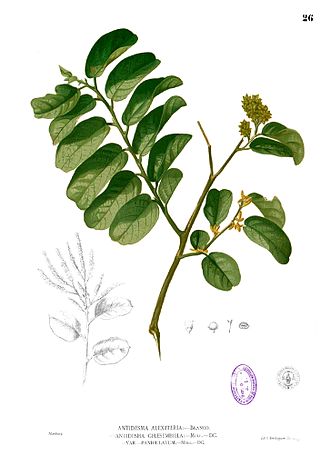
Antidesma ghaesembilla is a species of plant in the Phyllanthaceae family. It is native to an area from northern Australia to the Philippines, Zhōngguó/China, and west to India. The shrub or tree usually grows in moist soils in plant communities ranging from savannah to gallery forest to closed forest. It is associated with a number of species of fungus, insects and animals, including emus. Amongst the Mangarrayi and Yangman people of north Australia, the sweet ripe fruit of the tree are much appreciated and linked to the build-up season and to the koel. As well as food, the plant is used as a calendar-plant, for dyeing, in traditional medicine, in religious/magical practices, as fuel, and as an insecticide.
Terminalia petiolaris, commonly known as blackberry tree or billygoat plum, or marool in the local Bardi language, is a species of plant in the Combretaceae family. It is endemic to the coast of the Kimberley region of northern Western Australia.
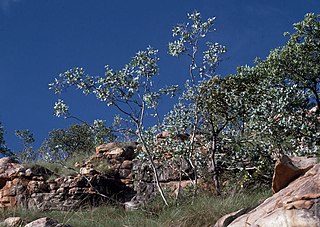
Eucalyptus mooreana, commonly known as Moore's gum, mountain white gum or King Leopold Range mallee, is a species of stunted, straggly tree or mallee that is endemic to the Kimberley region of Western Australia. It has smooth, powdery white bark, a crown of juvenile, sessile, stem-clasping leaves arranged in opposite pairs, flower buds arranged in groups of seven, white flowers and cup-shaped to hemispherical fruit.
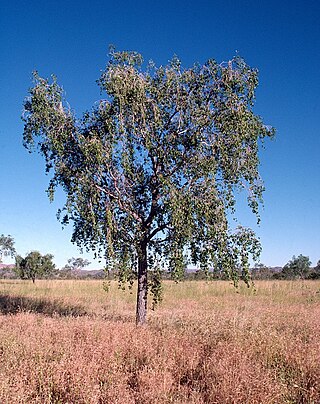
Terminalia arostrata, commonly known as crocodile tree or nutwood, is a tree of the family Combretaceae native to northern parts of Australia.
Terminalia canescens, commonly known as joolal, winged nut tree, or wingnut, and also known by its Aboriginal name djilanydjin in north-western Australia, is a tree of the family Combretaceae native to northern parts of Australia.
Terminalia cunninghamii, commonly known as pindan quondong, pindan walnut or kalumburu almond, is a tree or shrub of the family Combretaceae native to Western Australia. Some Aboriginal people know the plant as kumpaja.

Terminalia hadleyana is a tree of the family Combretaceae native to northern Australia.
Terminalia platyphylla, commonly known as wild plum, is a tree of the family Combretaceae native to northern Australia.
Cyperus zollingeri, commonly known as roadside flatsedge, is a sedge of the family Cyperaceae that is native to tropical areas of Australia, Africa and Asia.
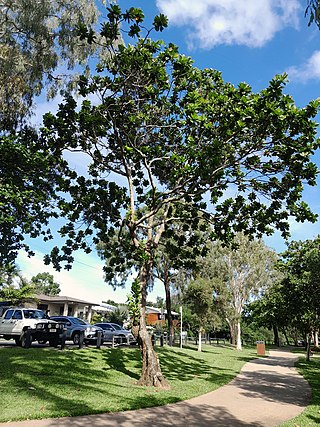
Terminalia arenicola, commonly known as beach almond or brown damson, is a tree in the family Combretaceae which is endemic to Queensland in Australia.

















